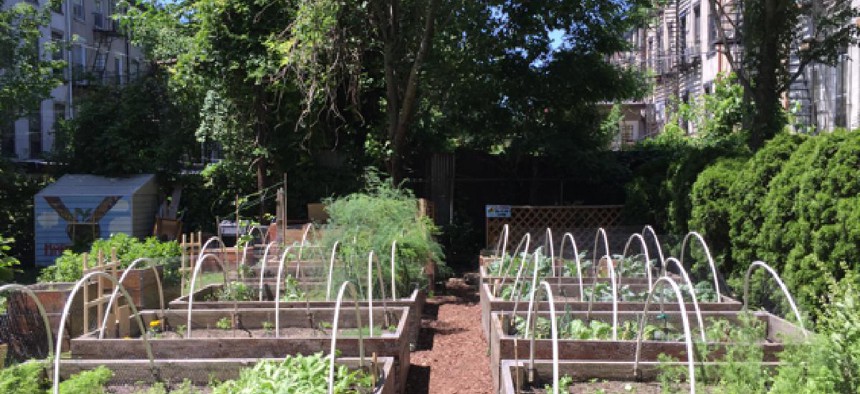“Green” your nonprofit

This year marks the 40th anniversary of farmers’ markets in New York City. Launched in 1976 with three markets (Union Square, Brooklyn, and an Upper West Side location), the city now hosts nearly 100 markets throughout the five boroughs.

The success of New York City’s farmers’ market network forms just part of our local food movement’s story. Restaurants have increasingly sought out and advertised direct farm partnerships, reflecting the growing public interest in locally sourced ingredients. Commercial urban agriculture enterprises like Brooklyn Grange and Gotham Greens have brought farming back to within the city’s limits. In 2015, Rooftop Reds brought a vineyard operation to the Brooklyn Navy Yard, returning commercial grape growing to New York City for the first time in over a century.
The nonprofit sector has also played a role in this movement, creating greater awareness of and access to local foods through public education and food justice advocacy. City Grower’s after-school programming has given hundreds of New York City youth hands-on knowledge of urban farming, composting and beekeeping. Just Food’s community supported agriculture (CSA) initiative has created stronger connections between thousands of New York City consumers and their local farmers. Projects from these organizations and dozens of other nonprofits have helped to make “local food” a known phrase and common cause for all New Yorkers.
However, public awareness of local food often positions the average New Yorker in a passive role, functioning as a consumer or a student of the movement. This ignores the amazing potential for the nonprofit sector to create access points and engage the populations we serve as active participants in the local food economy.
Furthermore, potential extends beyond food and agriculture issue-focused organizations, and can draw upon the existing knowledge and experience of nonprofits in job development, employment services, start-up incubation, supportive and affordable housing, day habilitation, public health, and countless other fields – in short, any nonprofit that seeks to build community or develop opportunity should be exploring involvement in New York’s local food movement.
As an example, my organization, Services for the UnderServed (SUS), has built its vocational development portfolio to include pathways for professional training in urban agriculture and food services. Building on internal horticultural knowledge through a therapeutic horticulture initiative, SUS developed a curriculum for an annual workshop series to teach plant propagation, Integrated Pest Management (IPM), plant identification and maintenance basics, composting, beekeeping and other core agricultural skills. This skill development can provide access not only to jobs in the growing commercial agriculture sector, but also in food processing, wholesale/retail sales, landscape management, and other crossover occupations.
SUS has also partnered with both nonprofit and for-profit organizations to create work experiences, apprenticeships, and community integration projects around local agriculture. SUS and Kingsborough Community College worked together to offer a culinary training program that focused on local foods harvested through the college urban farm. A partnership with Rooftop Reds provided hands-on practice for SUS clients in the specialized environment of a rooftop vineyard. This summer, SUS collaborated with Big Reuse to begin community organic waste collection in Bushwick, Brooklyn, as part of the New York City Compost Project.
As one final example, SUS took advantage of its existing therapeutic horticulture program to give participants direct access to the local market network. Produce grown at SUS client-run gardens is now offered for sale at East New York Farms’ farmers market, taking work already being done and translating it to an entrepreneurial opportunity. SUS similarly is exploring its horticulture programming to develop agricultural products (currently offering honey products, and piloting other sauces, mustards and pickles), creating an additional gateway for direct participation in food market and distribution networks.
As the local food movement grows, so does the opportunity for all nonprofits to benefit from participation in that movement. Your organization’s mission does not need an intrinsic connection to urban agriculture, nutrition or food justice for you to take advantage of involvement. Expand your vocational offerings to include “green” jobs development. Build complementary partnerships that give your clients urban agricultural knowledge and experiences. Take a more entrepreneurial perspective on any existing horticulture programming. Whatever your approach, your nonprofit can play a key role in giving your clients an active voice in our food system, and in keeping the local food movement accessible to all New Yorkers.
Mike Hollis is the urban farms manager at Services for the UnderServed. He coordinates a multi-divisional therapeutic horticulture program for individuals and families facing a range of challenges, including mental illness, developmental disabilities, and HIV/AIDS, often compounded by histories of homelessness, substance abuse, poverty, and unemployment. With over 30 agricultural and horticultural sites in backyards and rooftops citywide, the program engages over 400 clients annually in urban agriculture, vocational training, and nutritional programming.